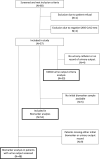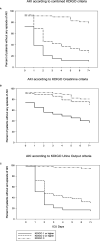COVID-19 patients in intensive care develop predominantly oliguric acute kidney injury
- PMID: 33190222
- PMCID: PMC7753792
- DOI: 10.1111/aas.13746
COVID-19 patients in intensive care develop predominantly oliguric acute kidney injury
Abstract
Background: Acute kidney injury (AKI) is a syndrome of reduced glomerular filtration rate and/or reduced urine flow associated with mortality in corona virus disease 2019 (COVID-19). AKI is often associated with renal tissue damage, which may lead to chronic kidney disease. Biomarkers of tissue damage may identify patients of particular risk.
Methods: In a prospective observational study of 57 patients admitted to intensive care, AKI incidence and characteristics was evaluated according to KDIGO criteria and related to days after admission. Urinary albumin, Neutrophil Gelatinase-Associated Lipocalin (NGAL), Kidney Injury Molecule 1 (KIM-1) and Plasma Tissue Inhibitor of MetalloProteinase 2 (TIMP-2) were analysed in 52 patients at admission. The majority (n = 51, 89%) of patients developed AKI, and 27 (47%) patients had predominantly oliguric AKI where oliguria was more severe than plasma Creatinine increase. Severe oliguria within first 2 days after admission was common (n = 37, 65%), whereas stage 2 and 3 AKI due to Creatinine occurred later than day 2 in 67% (12/18) of cases. Renal replacement therapy was started in 9 (16%) patients, and 30-day mortality was 28%. Urinary biomarkers were increased in a majority of patients, but did not robustly predict KDIGO stage. Most patients had microalbuminuria, and severe albuminuria (albumin Creatinine ratio > 30 mg/mmol) was found in n = 9 (17%) patients.
Conclusions: A majority of patients with COVID-19 admitted to the ICU develop AKI. The functional deficit is often low urinary volume, and initial levels of biomarkers are generally increased without clear relation to final AKI stage.
Keywords: COVID-19; acute kidney injury; biomarkers; intensive care.
© 2020 The Authors. Acta Anaesthesiologica Scandinavica published by John Wiley & Sons Ltd on behalf of Acta.
Conflict of interest statement
The authors have no conflicts of interest.
Figures


References
Publication types
MeSH terms
Substances
Grants and funding
LinkOut - more resources
Full Text Sources
Other Literature Sources
Medical
Research Materials
Miscellaneous

